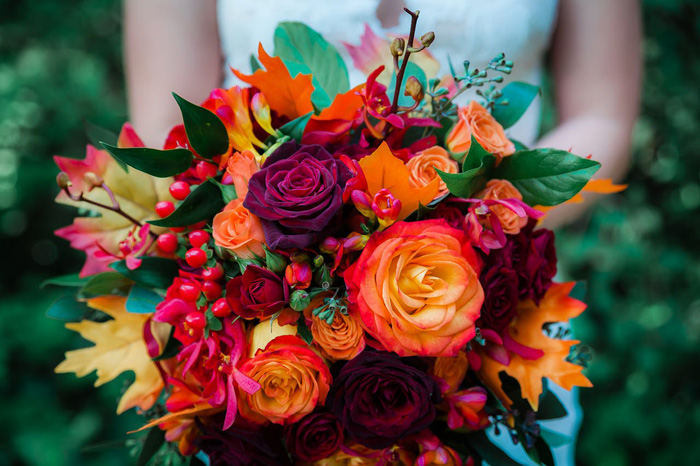服务咨询热线
400-8393-288
周一至周五: 8:30-17:30
法定节假日休息
冷知识:为什么新娘要在婚礼上拿手捧花?
为什么在西式婚礼上新娘都要拿着手捧花?据称这一做法早在古罗马时期就出现了,但原因可能和你想的不太一样,既不是为了避免新娘的手无处安放,也不是为了遮盖体味。

While the bridal bouquet isn’t exactly a wedding necessity—the show could technically go on without it—it’s still a pretty integral part of the ceremony. To put this in perspective, just imagine how odd it would seem for a bride to walk down the aisle empty-handed.
手捧花虽然不是婚礼的必需品——没有它理论上婚礼也能进行——但它仍然是仪式中非常重要的一部分。为了更好地理解这一点,你可以想象一下新娘空手走过通道会显得多么奇怪。
So where did the tradition come from? Though some have suggested wedding flowers were originally used to mask body odor before frequent bathing became the norm, that’s a misconception. In fact, the earliest bridal bouquets didn’t contain very many flowers, if any—instead, they mostly comprised herbs. According to Reader’s Digest, ancient Romans were the first to adopt the practice of sending their brides down the aisle with bundles of herbs, which symbolized things like fidelity and fertility.
那么这个传统从何而来呢?尽管有人提出,婚礼上的手捧花最初是用来掩盖体味的,因为经常洗澡在那时还没有成为常态,但这其实是个误解。实际上,最早的新娘手捧花并没有很多花——相反,它们主要由草本植物组成。据《读者文摘》报道,古罗马人最先采用让新娘手持一束草本植物走上红毯的这一做法,这些草本植物象征着忠诚和生育能力。
Dill, already a known aphrodisiac at the time, was especially common in those bouquets, and it was also often served at wedding receptions to help the bride and groom prepare to consummate their bond. Garlic was sometimes used in the bouquets, too, since it was thought to protect the bride from bad luck or evil spirits.
当时已知的催情药莳萝特别常见于这些手捧花中,它也经常在婚宴上供应,以帮助新娘和新郎圆房。大蒜有时也被用于手捧花,因为它被认为可以保护新娘免受厄运或邪灵的侵扰。
Over the following centuries, people started to introduce other flora into their wedding bouquets, flowers included. As Snopes reports, marigolds gained popularity in 16th-century England as a symbol of faithfulness and endless love, because marigolds are so faithful to the sun—blooming in daylight and closing their petals at night. And, like dill, they were considered an aphrodisiac.
其后数百年间,人们开始在婚礼手捧花中加入其他植物,包括花卉。据辟谣网站Snopes报道,在16世纪的英格兰,万寿菊作为忠诚和无尽爱情的象征而变得越来越受欢迎,因为万寿菊对太阳十分忠诚——总是在白天盛放,在夜晚收拢花瓣。而且,和莳萝一样,万寿菊也被认为有催情功效。
Then, during the Victorian era, floriography (the language of flowers) became a prevalent fad, and people began to send each other carefully assembled bouquets of flowers with specific meanings, which your handy floral dictionary could help you decipher. According to Atlas Obscura, pennyroyal meant “You must leave,” for example, while a pineapple would clearly convey to your lover that you think they’re perfect.
随后,在维多利亚时代,花语(花的语言)成为一种流行的时尚,人们开始互送精心搭配的具有特定含义的花束,当时还有帮助破解花束含义的花语小词典。据秘境舆图网站报道,举例来说,薄荷草意味着“你必须离开”,凤梨花则会清楚地向你的爱人传达你认为他/她很完美。
Secret flower messages fell out of fashion as the world shifted focus to World War I, but bridal bouquets never did—though you might want to make sure yours doesn’t contain any pennyroyal, just in case your soon-to-be spouse happens to be a closet floriographer.
在第一次世界大战爆发后,花语慢慢地不再流行,但是新娘手捧花却一直流传至今,只不过你可能需要确认一下花束中不包含薄荷草,以防你的另一半恰巧是一个隐藏的花语学家。
英文来源:Mental Floss
编译:丹妮
审校:董静、齐磊
图文来源:新华网、Variety、索尼影业、央视网 、每日经济新闻、 极目新闻、 红星新闻、 工人日报、福克斯新闻网、新浪、观察者网、卫报、BBC、sciencealert、 Pixar、Paramount Pictures、Sony、Warner Bros、Lucasfilm、Twitter、BBC、新华社、雅虎新闻、Oddity Central、纽约邮报、CBS新闻、美国有线电视新闻网、Unsplash、Pexels、中国日报等综合整理,新闻资讯均转载自其它媒体,目的在于传播更多信息,其他媒体如需转载,请与稿件来源方联系,如产生任何问题与本网无关;本网所发布的内容,图片,音乐,电影等片段,版权归原作者所有,仅供学习与研究,如果侵权,请提供版权证明,以便尽快删除。
标签: 广州翻译 东莞翻译 翻译 深圳翻译 东莞翻译公司 广州翻译公司 深圳翻译公司 十大翻译公司 中国翻译 翻译公司 最佳翻译公司
-
字字千钧,法意无界,亚加达翻译高效护航,值得拥有!2025-06-23
-
印度亿万富翁吞下一只蜜蜂后猝逝2025-06-17
-
发现“超级地球”!可能存在类地生命2025-06-06
-
全球好感度最新调查:中国8.8,美国-1.52025-06-04
-
首次发生!不听人类指挥,AI模型拒绝关闭2025-05-28
-
哈佛禁招令,比利时未来女王也被影响了2025-05-26
-
两个发胖时段,熬过去就能瘦?2025-05-21
-
首次公布!我国空间站内发现新物种2025-05-19
-
关于邀请各省区市翻译协会组织人员报名参加第三届全国翻译技术大赛的函2025-05-15
-
关于邀请各省区市翻译协会组织人员报名参加第三届全国翻译技术大赛的函2025-05-15
-
许昌对胖东来开展检查,结果公布2025-05-06
-
苏炳添,任院长!2025-04-28
-
中国翻译协会发布《2025中国翻译行业发展报告》和《2025全球翻译行业发展报告》2025-04-28
-
“中国人不怕,中国人能吃苦!”2025-04-21



